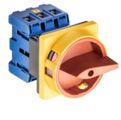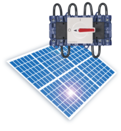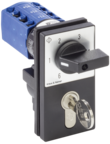Info
Isolator selection made easy

The purpose of isolation is to provide protection against electrical hazards such as electric shock, burns and ballistics (the effects of arc flash), and the unintentional start-up of machinery. Commonly referred to as Isolating switches, an “On Load Isolator” is the most common piece of equipment used to achieve isolation. They are switch devices that cut off a circuit or equipment from a source of power and ensure that the electrical circuit or equipment is completely isolated in order to conduct maintenance, servicing, modification or repair.
For the above applications, a 1 pole isolator for single phase, or a 3 pole isolator for three phase are generally installed. They are electrically capable of making and breaking the load under normal conditions and specified overload conditions and also pass electrical and mechanical tests to comply as isolators. Example; these switches cannot be turned to OFF (handle moved to the off position) unless all the main contacts have physically opened. Should there be one welded contact, the OFF position cannot be reached, and a padlock device cannot be fitted, even with three times the normal operating force being applied and when released the handle returns to ON. This communicates very effectively that isolation has not been achieved and that the circuit or equipment is not safe, and has not been isolated. In addition to the physical handle test, there are electrical threshold tests to ensure current will not jump the contact gap or track to earth under specified fault conditions.

Identifying “On Load Isolators” by the product label
On Load Isolators are easily identified by the symbol on the switch label, which is compulsory. It is logically a combination of the “Switch”, and the “Disconnector” (Isolation) symbols, explained to the right.
On Load Isolators are labelled with both an AC-21 Amp rating, and an AC-23 kW rating. The AC-21 Amp rating is applicable for resistive loads and the AC-23 kW rating for inductive motor loads. The table to the right lists a few examples of common electrical loads.
Off Load Isolator – Disconnector
Identified with the Isolation symbol only, off load isolators are not rated to make or break loads. These isolators have utilisation categories AC-20 / AC-21 or DC-20 / DC-21 and can carry the thermal current of the load in the closed position only.
An off load isolator must be linked to a device that makes the load after the isolator’s main contacts close, and breaks the load before they open. This is generally achieved by a Late Make Early Break auxiliary contact on the isolator that is wired to a drive, soft starter or circuit breaker.
The additional complexity of installing Off Load Isolators for single load installations, small machines and domestic installations is over complicated and has significant additional cost.
Should the Isolator be switching the load directly ensure it has the Switch Disconnector Symbol.
Auxiliary contacts on Isolators provide important functionality and shall be discussed in a later article.

Padlock Device Colours
Isolators from all manufacturers have different handle colours and combinations: grey, black, black and red, all of which identify the isolators as “Main Switches” which safely isolate a load.
However, the red and yellow handle combination has international significance, identifying the device as an ‘Emergency Switch” suitable for use in an emergency.
Should a fault or accident occur and the process needs to be shut down immediately, all devices identified by a Red and Yellow colour combination will be capable of stopping the process.
Best practice is to install Isolators with Red handles and Yellow surrounds if it is intended that the isolator be available for use in an emergency, or other coloured handles if not, to eliminate confusion during an emergency situation.
Related articles:
Isolators for Water Heaters
Enclosure Selection for your Switchgear






